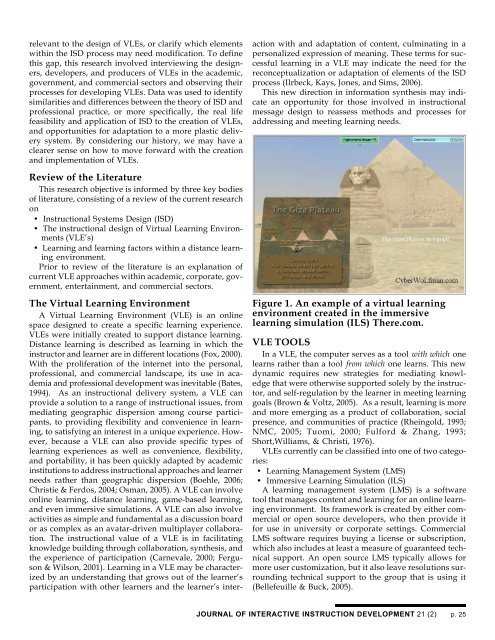Instructional Design Factors as they Relate to the ... - Anitacrawley.net
Instructional Design Factors as they Relate to the ... - Anitacrawley.net
Instructional Design Factors as they Relate to the ... - Anitacrawley.net
You also want an ePaper? Increase the reach of your titles
YUMPU automatically turns print PDFs into web optimized ePapers that Google loves.
elevant <strong>to</strong> <strong>the</strong> design of VLEs, or clarify which elementswithin <strong>the</strong> ISD process may need modification. To defi<strong>net</strong>his gap, this research involved interviewing <strong>the</strong> designers,developers, and producers of VLEs in <strong>the</strong> academic,government, and commercial sec<strong>to</strong>rs and observing <strong>the</strong>irprocesses for developing VLEs. Data w<strong>as</strong> used <strong>to</strong> identifysimilarities and differences between <strong>the</strong> <strong>the</strong>ory of ISD andprofessional practice, or more specifically, <strong>the</strong> real lifefe<strong>as</strong>ibility and application of ISD <strong>to</strong> <strong>the</strong> creation of VLEs,and opportunities for adaptation <strong>to</strong> a more pl<strong>as</strong>tic deliverysystem. By considering our his<strong>to</strong>ry, we may have aclearer sense on how <strong>to</strong> move forward with <strong>the</strong> creationand implementation of VLEs.The Virtual Learning EnvironmentA Virtual Learning Environment (VLE) is an onlinespace designed <strong>to</strong> create a specific learning experience.VLEs were initially created <strong>to</strong> support distance learning.Distance learning is described <strong>as</strong> learning in which <strong>the</strong>instruc<strong>to</strong>r and learner are in different locations (Fox, 2000).With <strong>the</strong> proliferation of <strong>the</strong> inter<strong>net</strong> in<strong>to</strong> <strong>the</strong> personal,professional, and commercial landscape, its use in academiaand professional development w<strong>as</strong> inevitable (Bates,1994). As an instructional delivery system, a VLE canprovide a solution <strong>to</strong> a range of instructional issues, frommediating geographic dispersion among course participants,<strong>to</strong> providing flexibility and convenience in learning,<strong>to</strong> satisfying an interest in a unique experience. However,because a VLE can also provide specific types oflearning experiences <strong>as</strong> well <strong>as</strong> convenience, flexibility,and portability, it h<strong>as</strong> been quickly adapted by academicinstitutions <strong>to</strong> address instructional approaches and learnerneeds ra<strong>the</strong>r than geographic dispersion (Boehle, 2006;Christie & Ferdos, 2004; Osman, 2005). A VLE can involveonline learning, distance learning, game-b<strong>as</strong>ed learning,and even immersive simulations. A VLE can also involveactivities <strong>as</strong> simple and fundamental <strong>as</strong> a discussion boardor <strong>as</strong> complex <strong>as</strong> an avatar-driven multiplayer collaboration.The instructional value of a VLE is in facilitatingknowledge building through collaboration, syn<strong>the</strong>sis, and<strong>the</strong> experience of participation (Carnevale, 2000; Ferguson& Wilson, 2001). Learning in a VLE may be characterizedby an understanding that grows out of <strong>the</strong> learner’sparticipation with o<strong>the</strong>r learners and <strong>the</strong> learner’s interactionwith and adaptation of content, culminating in apersonalized expression of meaning. These terms for successfullearning in a VLE may indicate <strong>the</strong> need for <strong>the</strong>reconceptualization or adaptation of elements of <strong>the</strong> ISDprocess (Ilrbeck, Kays, Jones, and Sims, 2006).This new direction in information syn<strong>the</strong>sis may indicatean opportunity for those involved in instructionalmessage design <strong>to</strong> re<strong>as</strong>sess methods and processes foraddressing and meeting learning needs.Review of <strong>the</strong> LiteratureThis research objective is informed by three key bodiesof literature, consisting of a review of <strong>the</strong> current researchon• <strong>Instructional</strong> Systems <strong>Design</strong> (ISD)• The instructional design of Virtual Learning Environments(VLE’s)• Learning and learning fac<strong>to</strong>rs within a distance learningenvironment.Prior <strong>to</strong> review of <strong>the</strong> literature is an explanation ofcurrent VLE approaches within academic, corporate, government,entertainment, and commercial sec<strong>to</strong>rs.Figure 1. An example of a virtual learningenvironment created in <strong>the</strong> immersivelearning simulation (ILS) There.com.VLE TOOLSIn a VLE, <strong>the</strong> computer serves <strong>as</strong> a <strong>to</strong>ol with which onelearns ra<strong>the</strong>r than a <strong>to</strong>ol from which one learns. This newdynamic requires new strategies for mediating knowledgethat were o<strong>the</strong>rwise supported solely by <strong>the</strong> instruc<strong>to</strong>r,and self-regulation by <strong>the</strong> learner in meeting learninggoals (Brown & Voltz, 2005). As a result, learning is moreand more emerging <strong>as</strong> a product of collaboration, socialpresence, and communities of practice (Rheingold, 1993;NMC, 2005; Tuomi, 2000; Fulford & Zhang, 1993;Short,Williams, & Christi, 1976).VLEs currently can be cl<strong>as</strong>sified in<strong>to</strong> one of two categories:• Learning Management System (LMS)• Immersive Learning Simulation (ILS)A learning management system (LMS) is a software<strong>to</strong>ol that manages content and learning for an online learningenvironment. Its framework is created by ei<strong>the</strong>r commercialor open source developers, who <strong>the</strong>n provide itfor use in university or corporate settings. CommercialLMS software requires buying a license or subscription,which also includes at le<strong>as</strong>t a me<strong>as</strong>ure of guaranteed technicalsupport. An open source LMS typically allows formore user cus<strong>to</strong>mization, but it also leave resolutions surroundingtechnical support <strong>to</strong> <strong>the</strong> group that is using it(Bellefeuille & Buck, 2005).JOURNAL OF INTERACTIVE INSTRUCTION DEVELOPMENT 21 (2) p. 25
















